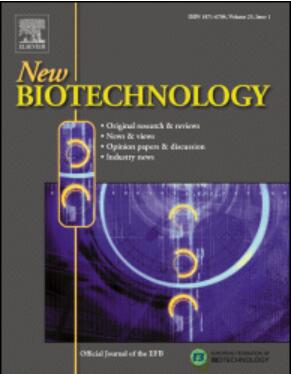与立即整合全套活性拷贝相比,基因拷贝的逐步激活导致亚克隆的最终滴度更高
IF 4.9
2区 生物学
Q1 BIOCHEMICAL RESEARCH METHODS
引用次数: 0
摘要
对生产治疗性蛋白质的需求不断增加,促使工业和学术机构追求具有高生产率的哺乳动物表达平台的发展。虽然有快速有效地将多个转基因拷贝整合到基因组中的方案,但它们需要大量的时间和资源来筛选大量的克隆。一个促成因素是,由于高生产力造成的压力,没有足够的时间来适应细胞能力,高生产者有从选定的小型池中消失的趋势。在这里,我们开发了一种策略来稳定激活最初被抑制的多拷贝编码盒中的单个拷贝,其中包含2个GFP-Fc和2个BFP-Fc基因,每个基因融合到Fc区域进行分泌。这个工具箱可以通过CRISPR/ cas9介导的抑制因子的删除来激活基因。随后,生产者可以根据增加的GFP或BFP荧光进行分类,并通过测量分泌的总Fc蛋白来评估。我们证明,初始抑制基因的逐步激活优于从一开始就具有相同数量基因活性的对照细胞系,证明了GFP和BFP的荧光信号更高,BFP、GFP和Fc基因的mRNA水平增加,以及分泌的Fc融合蛋白滴度增强。这项研究证明了细胞通过调节基因表达模式和资源通道来适应新挑战的能力,以适应高生产负荷。本文章由计算机程序翻译,如有差异,请以英文原文为准。
Stepwise activation of gene copies results in higher final titers of subclones compared to immediate integration of the full set of active copies
The increasing demand for production of therapeutic proteins has encouraged both industrial and academic institutions to pursue the development of mammalian expression platforms with high productivities. While protocols for rapid and efficient integration of multiple transgene copies into the genome are available, they require substantial time and resources for screening numerous clones. A contributing factor is the tendency of high producers to disappear from the selected mini-pools due to the stress caused by high productivity without adequate time for adaptation of cellular capacities. Here, we have developed a strategy to stably activate individual copies within an initially repressed multicopy coding cassette harboring 2 GFP-Fc and 2 BFP-Fc genes, each fused to an Fc region for secretion. This toolbox enables gene activation via CRISPR/Cas9-mediated deletion of the repressor elements. Subsequently, producers can be sorted based on increased GFP or BFP fluorescence and assessed by measuring the secreted total Fc protein. We demonstrate that the stepwise activation of initially repressed genes outperforms a control cell line with the same number of genes active from the outset, as evidenced by higher fluorescence signals from GFP and BFP, increased mRNA levels for BFP, GFP, and Fc genes, and enhanced titer of secreted Fc fusion protein. This study demonstrates the ability of cells to adapt to new challenges by modulating both gene expression patterns and channeling of resources to accommodate high production loads.
求助全文
通过发布文献求助,成功后即可免费获取论文全文。
去求助
来源期刊

New biotechnology
生物-生化研究方法
CiteScore
11.40
自引率
1.90%
发文量
77
审稿时长
1 months
期刊介绍:
New Biotechnology is the official journal of the European Federation of Biotechnology (EFB) and is published bimonthly. It covers both the science of biotechnology and its surrounding political, business and financial milieu. The journal publishes peer-reviewed basic research papers, authoritative reviews, feature articles and opinions in all areas of biotechnology. It reflects the full diversity of current biotechnology science, particularly those advances in research and practice that open opportunities for exploitation of knowledge, commercially or otherwise, together with news, discussion and comment on broader issues of general interest and concern. The outlook is fully international.
The scope of the journal includes the research, industrial and commercial aspects of biotechnology, in areas such as: Healthcare and Pharmaceuticals; Food and Agriculture; Biofuels; Genetic Engineering and Molecular Biology; Genomics and Synthetic Biology; Nanotechnology; Environment and Biodiversity; Biocatalysis; Bioremediation; Process engineering.
 求助内容:
求助内容: 应助结果提醒方式:
应助结果提醒方式:


